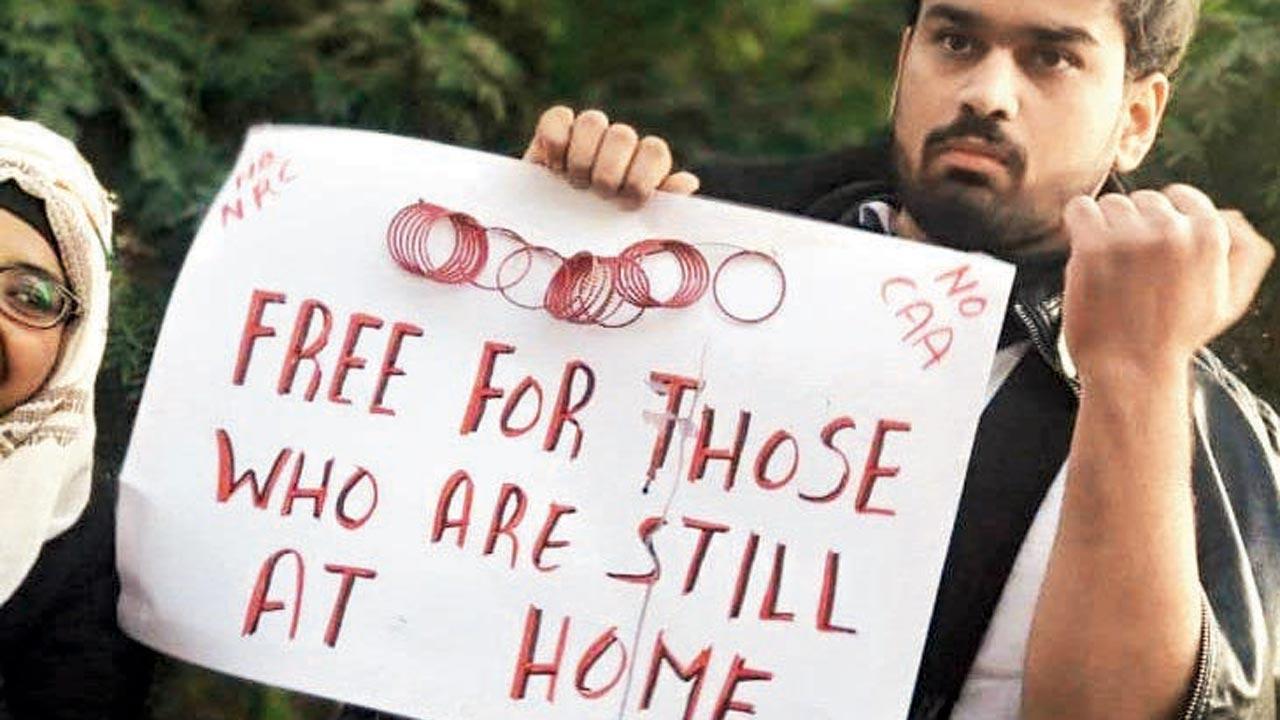He chose not to implicate fellow protesters, even when staring at a jail term for ‘conspiring’ to foment the 2020 Delhi riots; like Bhagat Singh and Ashfaqullah, he sacrificed himself. But who will take up his cause?

During the anti-CAA protests at Chand Bagh, Athar was assigned the task of managing the stage and coordinating with the local police. Pic/Twitter
 For a 24-year-old, Athar Khan had just too many choices to make ever since the protests against the Citizenship (Amendment) Act, 2019 rocked Delhi. He was, for instance, cautioned by his uncle Najmuddin, an activist in his own right, to keep a little distance from the frontline of the battle raging against the Indian state’s discriminatory citizenship policy—and not come in the crosshairs of the Police. In a voice quavering with passion, Athar lectured Najmuddin and his parents on how the CAA, along with the process of preparing the National Register of Citizens, would devastate Muslims.
For a 24-year-old, Athar Khan had just too many choices to make ever since the protests against the Citizenship (Amendment) Act, 2019 rocked Delhi. He was, for instance, cautioned by his uncle Najmuddin, an activist in his own right, to keep a little distance from the frontline of the battle raging against the Indian state’s discriminatory citizenship policy—and not come in the crosshairs of the Police. In a voice quavering with passion, Athar lectured Najmuddin and his parents on how the CAA, along with the process of preparing the National Register of Citizens, would devastate Muslims.
ADVERTISEMENT
It was thus that when the residents of Chand Bagh, a locality in Northeast Delhi, decided to organise a sit-in demonstration against the CAA, Athar was assigned the task of managing the stage and coordinating with the local police regarding the protest. Athar gave his all to make the Chand Bagh dharna a success.
Hours after Bharatiya Janata Party wannabe leader Kapil Mishra delivered a speech, dripping with threats and hate, on February 23, 2020, Northeast Delhi erupted. Najmuddin and Athar’s mother Noorjahan remonstrated with Athar to evacuate the protest site. He shot back, “Should I abandon the protesting women?” A day later, the shamiana under which the women were protesting went up in flames. The Chand Bagh protest was over.
By then, though, Mishra had tweeted a video of the Chand Bagh protest, portraying Athar as its leader. He was a marked man now.
There is a backstory to Mishra targeting Athar, who participated during the India Against Corruption movement and, like so many other young Delhiites then, believed idealism and politics could be combined. Both he and Najmuddin joined the Aam Aadmi Party. Chand Bagh falls in Karawal Nagar, the Assembly constituency of Mishra who was then an AAP leader. Athar joined Mishra’s social media team.
Mishra lost in 2013, then won in 2015. Appointed a minister in Delhi, Mishra had been to Athar’s home on a couple of occasions. In 2017, Mishra joined the BJP soon after he was sacked from the AAP. Yet Mishra, Najmuddin says, approached Athar to help him out in the 2020 Assembly election campaign. Citing their ideological differences, Athar rebuffed Mishra.
Even wannabe BJP leaders do not forget a perceived slight.
The Delhi Police (Crime Branch), in June, began serving notices on Athar, who was out of the Capital then. When he returned to the city, Najmuddin accompanied Athar to the Crime Branch. Many hours later, to his uncle, Athar narrated what had happened during the interrogation. The officers told Athar they had witnesses—Najmuddin calls them informers—who had testified against him. Najmuddin told me, “They slapped and hit Athar with lathis.”
That, in police parlance, is called “softening up” a person for interrogation. They showed him videos of the Chand Bagh protest and asked him to identify people in the footage. Athar named only those who had already been arrested. He had to merely snitch on his comrades to evade jail, as some civil rights activists are said to have done.
But that is not Athar, whom the Delhi Special Cell now summoned. They placed the cards on the table. They named two persons and said, “Implicate them and you can walk out free.” They asked him to think hard before coming over to their office on July 2.
Najmuddin told Athar, “Basically, my boy, you have to decide whether you want history to remember you as a Bhagat Singh or an Ashfaqullah; or as a Mir Jafar or a Jaichand.” Athar turned down the deal offered to him. He was arrested on July 2, and booked under the Unlawful Activities (Prevention) Act for conspiring to foment the riots in Northeast Delhi.
The news of the arrest of Athar saw his father slump into silence. Athar’s mother did not leave her bed for a week. His father met Athar only once at Mandoli Jail, where he was transferred after a spell in Tihar, and became an emotional wreck. Athar’s mother has not had the nerves to visit her son.
Athar was their strength. When the father’s hand embroidery business collapsed, Athar began to work at a call centre, even as he enrolled for a BBA correspondence course at the Sikkim Manipal University. The family rented out two of the four storeys of their house, built on a 60-square feet plot. The family now runs a small shop of spices. Their total monthly income rarely touches Rs 35,000.
Athar’s lower middle-class background explains the treatment meted out to him. He is not an Umar Khalid or a Sharjeel Imam. Who would take up his cause? His humiliation continues at Mandoli Jail. For instance, he is strip-searched, with even his underwear taken off, every time he returns from a court hearing. “I did an encounter once. So shut up,” a guard once responded to Athar’s protest.
The new India is too heartless to bother about Athar’s fate. Even his one-time hero Arvind Kejriwal has yet to speak about young Delhiites jailed under UAPA. And to think, Bhagat Singh is veritably the AAP’s mascot, whose self-sacrificing spirit Athar decidedly embodies. History, hopefully, will serenade Athar, prompting another generation to exclaim, ‘What a man!’
The writer is a senior journalist
Send your feedback to mailbag@mid-day.com
The views expressed in this column are the individual’s and don’t represent those of the paper
 Subscribe today by clicking the link and stay updated with the latest news!" Click here!
Subscribe today by clicking the link and stay updated with the latest news!" Click here!








